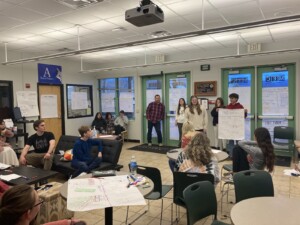Design Fix

Joel Rose, CEO of School of One in New York City, answers questions in the run up to the Innovate to Education Symposium being held by SIIA at the Harvard Club in Boston August 4-6, 2010. For more information on the symposium and to register, please visit the SIIA Innovate to Educate registration page.
ed: What is your vision for personalization?
I think it means that students receive instructional content that is personalized to their particular academic needs and ways of learning.
ed: Where does technology fit into that?
I think we need school designs that accomplish that personalized vision by integrating, instruction, professional development, leadership, options and technology. It’s one of the necessary components of an integrated design that serves that need. It doesn’t end or begin with technology, but technology is a piece of it.
ed: What are some of the challenges being faced by the effort to bring personalization into the education system?
There is one big challenge, and that’s how nearly impossible it is for an individual teacher to personalize learning for 28 kids, during five periods a day. Even if we do that, it’s not enough. We have to complement the work of great teachers with systems and technologies that can enable personalized learning. It’s a design challenge.
ed: What do you mean by that, it being a design challenge?
It’s the way we designed our schools, by putting 28 kids in a room, calling that sixth grade and putting one teacher in that room. And making that assumption that a kid can make that one year of growth. … that’s a design assumption that is incredibly flawed.
ed: This is interesting. You are so far the first person I’ve talked to about this that seems to be talking specifically about an issue of design, as if the entire process is a design that’s flawed, or shaped differently than it could be. What shapes your thinking on this?
You are already starting from a position that in itself is a restraint. We are so accustomed to think of school in this way, the idea that there’s a different way of doing it doesn’t really enter into our minds. How we narrowly redesigned roles in school that have kind of calcified how we think about school. A lot of things we have done have just cascaded on top of this system.
[During this moment, Joel talked about the problem of answering needs for design solutions by just ordering more laptops, but essentially, ordering more computers doesn’t do anything unless there is a system in place that really accounts for outcomes, which we get to in the next question.]They can’t get integrated into how a classroom operates.
Until we fundamentally get to this design question…”This is where we want kids to be at the end of the year,” “This is the best way of doing that,” until we start asking these fundamental questions, we are going to stay where we are.
ed: So how do we get there?
We have to have a common measure of success. Separating what we want kids to know from how we deliver it is vital to the equation. Second, we need to find ways to fund and support a number of innovations at various stages of development that are aligned to that outcome, and have an opportunity to iterate innovations within existing schools. Then, we need to have a way to rigorously evaluate the effectiveness of those innovations, although in a way that allows for failure at the early stage, because that’s part of the process. It allows us when the time is appropriate to say this worked and this didn’t and generate that engine of innovation. I think we need some proof points, to show what kind of results you can get in that context. If we do those things…I think we can get there.
ed: This was interesting, so where does all of this intersect with equity and making sure every student is receiving quality instruction?
For years we have been focused on equity of inputs. The reality is that kids come to schools with different sets of needs. Just making instruction available to kids is not equity; I would argue that it’s the opposite of equity. I think we focus on equity of outcomes. More personalized approaches for different kinds of students, with same outcomes but different pathways to get there.







0 Comments
Leave a Comment
Your email address will not be published. All fields are required.